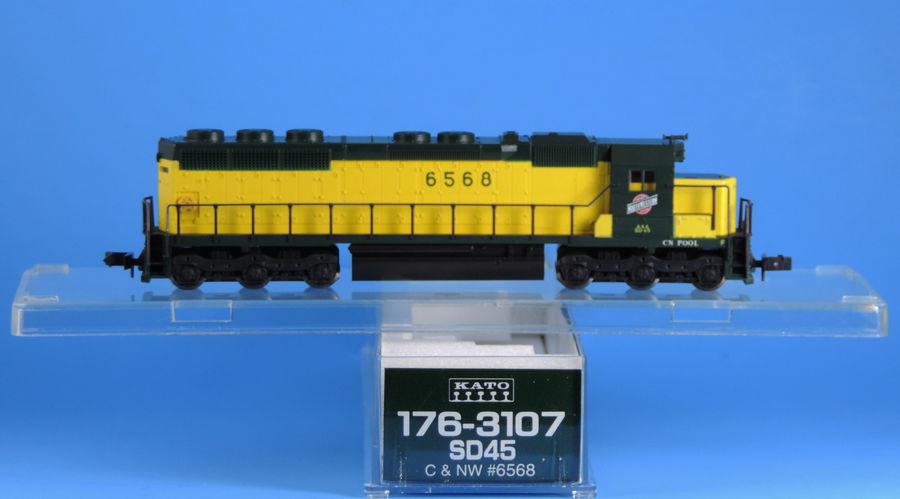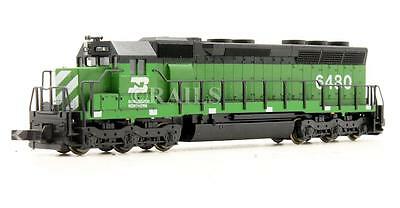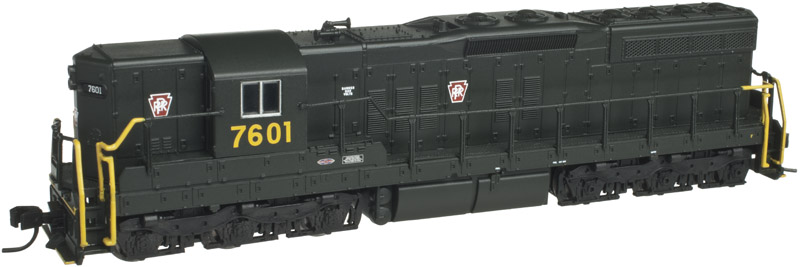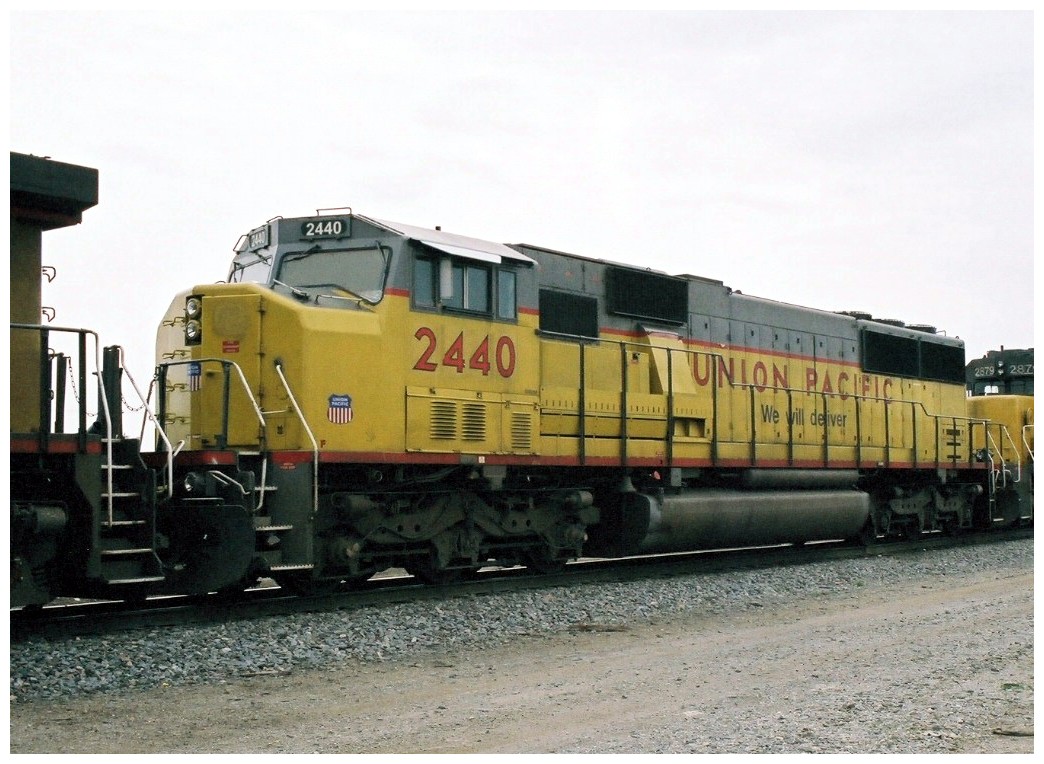Specific Item Information: 2 Window Cab
Model Information: Atlas introduced the SD60 in 1998. The SD50 and SD60M followed in 1999. In 2002 they revised the SD60M and SD50. In 2005, Atlas revised the SD60. All three models (SD60, SD60M and SD50) share the same mechanism and differ only in shell detailing. These models also come with uninstalled detail parts such as snow-plow and winterization hatches. These details must be installed by the owner.
The revised versions all carry typical post-2000 mechanisms. Therefore, we see features such as dial flywheels, all-wheel pickup and drive, blackened metal wheels, bi-directional lighting, a split-frame DCC-Ready chassis and easily-swappable body-mount couplers. The revised version feature Atlas' slow-speed motor, golden white LEDs and nicely painted two-tone handrails. Yes, they run very nicely.
The revised versions all carry typical post-2000 mechanisms. Therefore, we see features such as dial flywheels, all-wheel pickup and drive, blackened metal wheels, bi-directional lighting, a split-frame DCC-Ready chassis and easily-swappable body-mount couplers. The revised version feature Atlas' slow-speed motor, golden white LEDs and nicely painted two-tone handrails. Yes, they run very nicely.
DCC Information: The revised version of this model is DCC ready. It is available either in DC or DCC-equipped, with Lenz LE062XF for earlier runs, and with NCE N12A1 for more recent ones.
Models accept the following after market plug-in decoders:
- Digitrax DN163A1: 1 Amp N Scale Mobile Decoder for Atlas N-Scale SD60, SD60M, SD50 and others.
- TCS ALD4: Four Function decoder, for Atlas Long length Drop-in.
- NCE N12A1: Plug and play decoder for N-Scale Atlas SD50, SD60M, SD60.
Models accept the following after market plug-in decoders:
- Digitrax DN163A1: 1 Amp N Scale Mobile Decoder for Atlas N-Scale SD60, SD60M, SD50 and others.
- TCS ALD4: Four Function decoder, for Atlas Long length Drop-in.
- NCE N12A1: Plug and play decoder for N-Scale Atlas SD50, SD60M, SD60.
Prototype History: The EMD SD60 is a 3,800 horsepower (2,800 kW), 6-axle diesel-electric locomotive built by General Motors Electro-Motive Division. Intended for heavy-duty drag freight or medium-speed freight service. It was introduced in 1984, and production ran until 1995.
The development of the 16-cylinder EMD 50 and 60 series locomotives in the late 1970s and early 1980s was spurred by the introduction of 3,600 horsepower (2,700 kW) 16-cylinder GE B36-7 (B-B) and GE C36-7 (C-C) locomotives by EMD's main competitor General Electric. EMD previously manufactured the 3,600 hp (2,700 kW) 20-cylinder SD45 and SD45-2 locomotives, but they had a reputation for high fuel consumption. In 1980, the SD50 model was added to the EMD Catalog. However, the SD50's electrical reliability was poor and, similarly, the 3,500 horsepower (2,600 kW) 16-645F engine had poor mechanical reliability, both believed to be largely due to excessive vibration from the 950 maximum rpm of the 645F prime mover. It was time to develop a replacement for the venerable 645 engine which, in its earlier 16-645E form, had proved to be exceptionally reliable. EMD therefore quickly commenced development of the SD60 series, which would eliminate the weaknesses of the SD50. The lessons learned in developing the 645F crankcase and crankshaft (for the earlier 20-645E, and the then-current 16-645F) were incorporated in the replacement, the 710G, first employed in the SD60. Although the carbody and frame are nearly indistinguishable from the earlier SD50, the SD60 featured the new 16-cylinder EMD 710G3A prime mover, AR-11 traction alternator, D-87 traction motors and a microprocessor-based control system that governed various electrical systems within the locomotive (e.g., wheel slip and transition).
The SD60M features a "North American safety cab" design and has a full-width short hood. Early models featured a three-piece windshield with vertical windows (nicknamed "triclops"), identical to the windshields found on EMD's SD40-2F and F59PH models. Later production used two windshield panes that were sloped back, and had a somewhat shorter nose. EMD's F59PH is based on the SD60M. Purchasers of this model included Conrail, Union Pacific Railroad, Burlington Northern Railroad and the Soo Line Railroad.
From Wikipedia
Read more on American-Rails.com
The development of the 16-cylinder EMD 50 and 60 series locomotives in the late 1970s and early 1980s was spurred by the introduction of 3,600 horsepower (2,700 kW) 16-cylinder GE B36-7 (B-B) and GE C36-7 (C-C) locomotives by EMD's main competitor General Electric. EMD previously manufactured the 3,600 hp (2,700 kW) 20-cylinder SD45 and SD45-2 locomotives, but they had a reputation for high fuel consumption. In 1980, the SD50 model was added to the EMD Catalog. However, the SD50's electrical reliability was poor and, similarly, the 3,500 horsepower (2,600 kW) 16-645F engine had poor mechanical reliability, both believed to be largely due to excessive vibration from the 950 maximum rpm of the 645F prime mover. It was time to develop a replacement for the venerable 645 engine which, in its earlier 16-645E form, had proved to be exceptionally reliable. EMD therefore quickly commenced development of the SD60 series, which would eliminate the weaknesses of the SD50. The lessons learned in developing the 645F crankcase and crankshaft (for the earlier 20-645E, and the then-current 16-645F) were incorporated in the replacement, the 710G, first employed in the SD60. Although the carbody and frame are nearly indistinguishable from the earlier SD50, the SD60 featured the new 16-cylinder EMD 710G3A prime mover, AR-11 traction alternator, D-87 traction motors and a microprocessor-based control system that governed various electrical systems within the locomotive (e.g., wheel slip and transition).
The SD60M features a "North American safety cab" design and has a full-width short hood. Early models featured a three-piece windshield with vertical windows (nicknamed "triclops"), identical to the windshields found on EMD's SD40-2F and F59PH models. Later production used two windshield panes that were sloped back, and had a somewhat shorter nose. EMD's F59PH is based on the SD60M. Purchasers of this model included Conrail, Union Pacific Railroad, Burlington Northern Railroad and the Soo Line Railroad.
From Wikipedia
Read more on American-Rails.com
Road Name History: The Union Pacific Railroad (reporting mark UP) is a freight hauling railroad that operates 8,500 locomotives over 32,100 route-miles in 23 states west of Chicago, Illinois and New Orleans, Louisiana. The Union Pacific Railroad network is the largest in the United States and employs 42,600 people. It is also one of the world's largest transportation companies.
Union Pacific Railroad is the principal operating company of Union Pacific Corporation (NYSE: UNP); both are headquartered in Omaha, Nebraska. Over the years Union Pacific Corporation has grown by acquiring other railroads, notably the Missouri Pacific, Chicago & North Western, Western Pacific, Missouri-Kansas-Texas, and the Southern Pacific (including the Denver & Rio Grande Western).
Union Pacific Corporation's main competitor is the BNSF Railway, the nation's second largest freight railroad, which also primarily services the Continental U.S. west of the Mississippi River. Together, the two railroads have a duopoly on all transcontinental freight rail lines in the U.S.
Read more on Wikipedia and on Union Pacific official website.
Union Pacific Railroad is the principal operating company of Union Pacific Corporation (NYSE: UNP); both are headquartered in Omaha, Nebraska. Over the years Union Pacific Corporation has grown by acquiring other railroads, notably the Missouri Pacific, Chicago & North Western, Western Pacific, Missouri-Kansas-Texas, and the Southern Pacific (including the Denver & Rio Grande Western).
Union Pacific Corporation's main competitor is the BNSF Railway, the nation's second largest freight railroad, which also primarily services the Continental U.S. west of the Mississippi River. Together, the two railroads have a duopoly on all transcontinental freight rail lines in the U.S.
Read more on Wikipedia and on Union Pacific official website.
Brand/Importer Information: In 1924 Stephan Schaffan, Sr. founded the Atlas Tool Company in Newark, New Jersey. In 1933 his son, Stephan Schaffan, Jr., came to work for his father at the age of sixteen. Steve Jr. built model airplanes as a hobby and frequented a local hobby shop. Being an enterprising young man, he would often ask the owner if there was anything he could do to earn some extra spending money. Tired of listening to his requests, the hobby-store owner threw some model railroad track parts his way and said, "Here, see if you can improve on this".
In those days, railroad modelers had to assemble and build everything from scratch. Steve Jr. created a "switch kit" which sold so well, that the entire family worked on them in the basement at night, while doing business as usual in the machine shop during the day.
Subsequently, Steve Jr. engineered the stapling of rail to fiber track, along with inventing the first practical rail joiner and pre-assembled turnouts and flexible track. All of these products, and more, helped to popularize model railroading and assisted in the creation of a mass-market hobby. The budding entrepreneur quickly outgrew the limitations of a basement and small garage operation. Realizing they could actually make a living selling track and related products, Steve and his father had the first factory built in Hillside, New Jersey at 413 Florence Avenue in 1947. On September 30, 1949, the Atlas Tool Company was officially incorporated as a New Jersey company.
In 1985, Steve was honored posthumously for his inventions by the Model Railroad Industry Association and was inducted into the Model Railroad Industry Hall of Fame in Baltimore, Maryland. In addition, Steve was nominated and entered into the National Model Railroad Association Pioneers of Model Railroading in 1995.
In the early 1990s, the Atlas Tool Company changed its name to Atlas Model Railroad Company, Inc.
In those days, railroad modelers had to assemble and build everything from scratch. Steve Jr. created a "switch kit" which sold so well, that the entire family worked on them in the basement at night, while doing business as usual in the machine shop during the day.
Subsequently, Steve Jr. engineered the stapling of rail to fiber track, along with inventing the first practical rail joiner and pre-assembled turnouts and flexible track. All of these products, and more, helped to popularize model railroading and assisted in the creation of a mass-market hobby. The budding entrepreneur quickly outgrew the limitations of a basement and small garage operation. Realizing they could actually make a living selling track and related products, Steve and his father had the first factory built in Hillside, New Jersey at 413 Florence Avenue in 1947. On September 30, 1949, the Atlas Tool Company was officially incorporated as a New Jersey company.
In 1985, Steve was honored posthumously for his inventions by the Model Railroad Industry Association and was inducted into the Model Railroad Industry Hall of Fame in Baltimore, Maryland. In addition, Steve was nominated and entered into the National Model Railroad Association Pioneers of Model Railroading in 1995.
In the early 1990s, the Atlas Tool Company changed its name to Atlas Model Railroad Company, Inc.
Item created by: Steve German on 2016-04-11 15:01:00. Last edited by George on 2024-01-26 20:28:56
If you see errors or missing data in this entry, please feel free to log in and edit it. Anyone with a Gmail account can log in instantly.
If you see errors or missing data in this entry, please feel free to log in and edit it. Anyone with a Gmail account can log in instantly.











